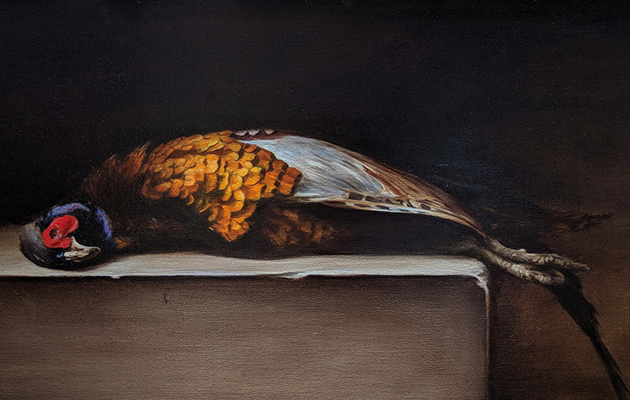Tanja Möderscheim explains how a love for her country’s heritage tulips and the Dutch Masters occasioned a change in career. By Janet Menzies
Originally a botanist and scientist, choice of subject matter for Tanja Möderscheim was obvious. Now she is inspired by the Dutch Masters for her authentic paintings, in which she hopes to capture silence.
For more sporting artists, Nick Orr captures a whole day in the field on a single feather. And discover why the great equestrian artists have enduring and universal appeal.
TANJA MÖDERSCHEIM
Four hundred years after its inspiration, the art of Tanja Möderscheim has found its moment, even though she has only been painting since 2004. After taking an MSc in biology, Möderscheim started on a PhD, unaware of her talent. “I was studying for my PhD in neurophysiology but I was finding it quite stressful, so I started painting to relax,” she remembers. “Very quickly it became almost an obsession. It has gradually taken over until about three years ago I reached the point where I could resign from my job in the pharmaceutical industry and paint full time.”

Still-life of peat-smoked salmon.
From the Netherlands but now living in London, Möderscheim was originally a botanist and scientist, so choice of subject matter was obvious. “In my painting I wanted to keep in touch with my Dutch roots and, of course, the Golden Age of Holland in the 17th century. I love the work of the Dutch Masters, especially Rachel Ruysch, one of the few female painters.” Dutch tulip painting fascinated her, “so I started to track down the old, original varieties from the tulip-craze period. I found a gene bank in Holland, the Hortus Bulborum, which produces small batches of the old varieties. I started ordering the bulbs and growing them, and every spring now I do a series of tulip paintings, which have a strong basis in heritage and tradition.”
Another of Möderscheim’s favourite Golden Age painters, Willem van Aelst, is known for his game scenes, the ‘game larder’ genre. Möderscheim explains: “In the 17th century, Holland was also famous for hunting and falconry. To reflect this I am painting the birds that were traditionally reserved for the aristocracy – like partridges or pheasants. So I found companies that supplied shot birds for taxidermy and got some and put them in the freezer. When I came to paint them I was amazed at their magnificent colours. For the composition I added some falconry equipment – hoods and jesses. Then I went along to exhibit at the Game Fair. Lots of falconry people visited my stand and they all told me that I had got the wrong equipment and it wasn’t used at the time. So I went to the falconry museum in the Dutch village of Valkenswaard and was able to look at the correct jesses and hoods.”
THE SEARCH FOR AUTHENTICITY
This search for authenticity has also led Möderscheim to research the pigments used by the Dutch Masters. “For blue I am using lapis lazuli from the same mine in Afghanistan that was producing it originally. It is extremely expensive, about £80 for a small tube. In the 17th century they used it to create green by adding a yellow overglaze made from berries – but you have to be careful because the yellow is not colourfast so over the years it disappears, which is why the leaves in Old Master paintings so often appear blue.”
With tulip bulbs worth more than gold, and semi-precious stones used for painting, the Golden Age of Holland was a time of immense luxury. As Calvinists, the Dutch were ambivalent about their sudden wealth and often tried to reconnect with the values and integrity of simpler times, a quest reflected in another of Möderscheim’s influences, Pieter Claesz, who worked in the ontbijt (breakfast) genre. “He was making simple still-life depictions of a loaf of bread and cheese on a plate, almost monochrome. These were more humble subjects, which I think the artists took pleasure in painting. This has now led me to painting artisan produce, including the BBC Food & Farming Awards finalists, and Provençal products.”

17th-century Haarlem faience plate with artichoke.
While paying attention to authenticity, Möderscheim is not a copyist. “My own interpretation is to show the subject matter in a quiet, serene and moody light. I am trying to paint silence, really. I particularly like the strijklicht, as we call it in Holland, a soft light that touches, almost caresses, the forms. All this has been a lovely, lovely journey. It was lovely to talk to the people at the Game Fair about the birds and about their passion. And for the Food & Farming Awards I did a still life of salmon, which had been smoked over peat in the Highlands. The 16 years since I started painting have been a process of finding and discovering values. These values of quality and something that is produced with care – these are really important values, that I think we are going back to now. People need something beautiful. The pendulum that had swung towards mass production has swung back toward something more lasting.”
View Tanja Möderscheim’s work at: dutchoils.com





